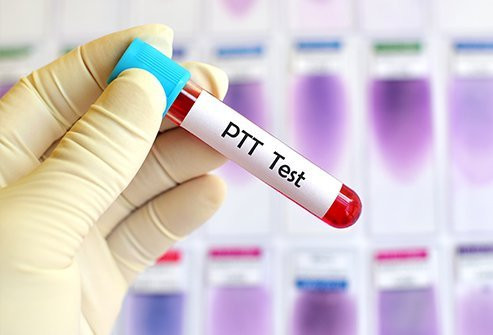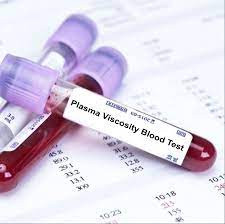Definisi
APTT (Activated Partial Thromboplastin Time) merupakan salah satu pemeriksaan pembekuan darah. Pemeriksaan ini mengukur waktu darah mengalami pembekuan dalam hitungan detik. Dalam keadaan normal, saat Anda mengalami luka atau perdarahan pada pembuluh darah, dalam waktu tertentu darah akan membeku sehingga perdarahan berhenti. Sehingga tubuh tidak kehilangan banyak darah.
Proses ini diperankan oleh protein pembekuan darah yang memberikan sinyal informasi kepada faktor pembekuan darah dalam tubuh Anda untuk membentuk pembekuan pada lokasi tubuh yang mengalami kerusakan atau perdarahan. Proses aktivasi faktor pembekuan ini membutuhkan waktu. Jika terjadi gangguan dalam proses pembentukan faktor pembekuan, hal ini dapat menimbulkan pembentukan faktor pembekuan pada darah mengalami gangguan, sehingga perdarahan dapat tetap berlangsung dan tubuh akan banyak kehilangan darah.
Terdapat banyak faktor pembekuan darah dalam tubuh Anda. Jika tubuh Anda tidak dapat menghasilkan salah satu faktor pembekuan darah, maka proses pembekuan darah tidak terjadi atau melambat. Sehingga waktu yang dibutuhkan darah menjadi beku melambat dan lama. Oleh karena itu, APTT adalah pemeriksaan yang melihat cara kerja dari suatu faktor pembekuan.
Pemeriksaan APTT sangat dibutuhkan pada beberapa penyakit gangguan pembekuan darah baik pada anak dan dewasa. Seperti penyakit gangguan pembekuan darah pada anak seperti hemofilia, pemeriksaan APTT dapat dijadikan untuk mendeteksi dini adanya hemofilia atau membantu menegakkan diagnosis hemofilia. Selain itu, pemeriksaan APTT juga dapat digunakan untuk memantau pengobatan pada pasien dewasa yang memperoleh terapi pengencer darah.
Jika dalam keluarga Anda terdapat riwayat penyakit gangguan pembekuan darah sebaiknya melakukan pemeriksaan APTT sebagai bentuk deteksi dini, terutama pada anak Anda. Sehingga kejadian perdarahan yang dapat mengancam nyawa dapat dicegah. Pemeriksaan APTT tidak dapat mendiagnosis secara spesifik penyakit pembekuan darah. Namun dari pemeriksaan ini dapat diketahui adanya gangguan pada faktor pembekuan darah. Sehingga dibutuhkan pemeriksaan lainnya untuk mendiagnosis adanya penyakit pembekuan darah seperti pemeriksaan PT (Prothrombine Time).
Indikasi
Pemeriksaan APTT dapat digunakan pada beberapa kondisi dan tujuan seperti di bawah ini:
- Jika Anda atau buah hati Anda mengalami gejala perdarahan secara spontan atau lebam pada kulit tanpa sebab yang jelas, gusi gampang berdarah, sering mengalami mimisan, mengalami luka yang tidak kunjung berhenti, nyeri dan bengkak pada sendi, ditemukan darah pada urin dan tinja serta pada perempuan dapat mengalami waktu haid yang lama dan keluar darah banyak dibandingkan normal.
- Selain itu, pemeriksaan APTT digunakan untuk skrining sebelum melakukan operasi pembedahan
- Pemeriksaan ini juga digunakan untuk memantau faktor pembekuan darah saat menggunakan obat pengencer darah
Kontraindikasi
Pemeriksaan APTT tidak memiliki kontraindikasi. Namun terdapat beberapa obat dan suplemen atau vitamin yang dapat mempengaruhi hasil pemeriksaan APTT. Obat-obatan pengencer darah seperti warfarin, heparin dan aspirin. Selain itu, obat seperti antialergi dan klorpromazin juga dapat mempengaruhi hasil pemeriksaan. Suplemen seperti vitamin C juga berpengaruh pada pemeriksaan APTT.
Persiapan Sebelum Pemeriksaan
Tidak ada persiapan khusus yang dibutuhkan saat Anda akan menjalani pemeriksaan APTT. Namun jika Anda sedang konsumsi obat-obatan, suplemen atau vitamin yang sudah disebutkan di atas. Sebaiknya Anda beritahukan kepada dokter. Karena obat-obatan dan vitamin tersebut dapat mempengaruhi hasil pemeriksaan dan membuat hasil yang diperoleh tidak akurat. Selain itu, Anda juga dapat melakukan aktivitas seperti biasa sebelum pemeriksaan dilakukan. Serta tidak ada batasan makan dan minum atau puasa pada pemeriksaan ini.
Prosedur Pemeriksaan
Pemeriksaan menggunakan sampel darah yang diambil dari pembuluh darah balik (vena). Pertama, petugas akan menentukan lokasi pengambilan sampel darah yaitu pada lipatan lengan. Kedua, petugas akan memasang karet pengikat (tourniquet) pada lengan dan memberikan instruksi mengepalkan tangan. Ketiga, petugas akan membersihkan kulit lipatan lengan dengan cairan antiseptik seperti kapas alkohol atau swab alkohol. Keempat, setelah kering petugas akan menusukkan jarum suntik pada lokasi pengambilan sampel. Kelima, darah akan ditampung pada tabung jarum suntik sesuai dengan kebutuhan yaitu sekitar 3mL-5mL. Keenam, selanjutnya tourniquet akan dilepas. Selanjutnya jarum suntik akan diangkat dari lokasi penyuntikan dan menekan bekas tempat penyuntikan dengan kapas alkohol. Sampel darah siap untuk dikirim ke laboratorium.
Nilai Normal dan Abnormal
Pemeriksaan APTT dihitung dengan menggunakan standar waktu dalam hitungan detik. Dalam pemeriksaan akan dibandingkan waktu yang dibutuhkan sampel darah pasien membeku dengan sampel kontrol dalam waktu yang bersamaan.
Nilai Normal
Nilai normal dari pemeriksaan APTT adalah 25-35 detik. Waktu ini menunjukkan rentang waktu normal darah mengalami pembekuan.
APTT Memanjang
Sedangkan nilai abnormal yaitu jika waktunya lebih panjang di atas 35 detik. Hal ini menunjukkan adanya gangguan pada faktor pembekuan darah sehingga darah membutuhkan waktu lebih lama untuk bisa membeku. Kondisi ini dapat menyebabkan perdarahan yang tidak kunjung berhenti dan dapat menimbulkan kehilangan banyak darah dari dalam tubuh.
APTT Memendek
Jika hasil pemeriksaan APTT waktunya lebih pendek yaitu di bawah 25 detik, maka disebut APTT melambat. Namun kondisi ini sangat jarang ditemui. Jika didapatkan hasil pemeriksaan APTT memendek maka terjadi pembekuan darah lebih cepat sehingga dapat berisiko terjadinya trombosis (pembekuan darah).
Hasil dan Saran (Pemeriksaan Lanjutan)
APTT Memanjang
Jika hasil pemeriksaan APTT Anda tidak normal yaitu di atas 35 detik maka disebut APTT memanjang. Artinya dibutuhkan waktu lebih lama darah Anda membeku dibandingkan waktu normal. Hal ini menunjukkan adanya gangguan atau masalah pada faktor pembekuan dalam tubuh Anda, kekurangan faktor pembekuan, tidak ada faktor pembekuan atau proses pembentukan faktor pembekuan terganggu. Hal ini dapat terjadi pada beberapa penyakit pembekuan darah seperti pasien yang menderita hemofilia, kekurangan vitamin K, penyakit von Willebrand, penyakit organ hati, leukimia dan pengunaan obat pengencer darah seperti warfarin dan heparin. Namun pemeriksaan APTT ini tidak dapat menentukan secara spesifik penyebab gangguan pembekuan darah. Sehingga dibutuhkan pemeriksaan lain seperti ACT (Activated Whole Trhombin), PT (Prothrombin Time), TT (Thrombine Time), faktor Von Willebrand dan hitung jenis platelet. Sehingga dengan tambahan pemeriksaan ini dapat membantu dokter menentukan diagnosis pasti adanya gangguan faktor pembekuan darah. Selain itu, dokter juga akan menyesuaikan dengan gejala yang dialami oleh Anda, riwayat penyakit faktor pembekuan darah dalam keluarga dan hasil pemeriksaan fisik yang ditemukan oleh dokter. Karena kebanyakan penyakit gangguan pembekuan darah diturunkan secara genetik.
APTT Memendek
Hasil pemeriksaan APTT juga dapat menunjukkan waktu lebih pendek yaitu di bawah 25 detik. Namun kondisi ini sangat jarang terjadi. Kondisi ini dapat meningkatkan risiko terjadinya pembekuan darah dalam pembuluh darah sehingga dapat menimbulkan trombosis atau bekuan darah yang lebih banyak dibandingkan normal.
Konsultasikan Ke Dokter yang Tepat
Segera konsultasikan ke dokter penyakit dalam terdekat jika hasil pemeriksaan APTT Anda tidak normal atau dokter penanggung jawab (DPJP) Anda di rumah sakit. Jika anak Anda yang mengalaminya, konsultasikan dengan dokter spesialis anak atau dokter penanggung jawabnya di rumah sakit; agar dilakukan evaluasi mengenai hasil pemeriksaan dan dokter dapat secara langsung melakukan pemeriksaan lanjutan. Sehingga dapat diketahui penyebab hasil pemeriksaan APTT Anda tidak normal.
Mau tahu informasi seputar hasil pemeriksaan laboratorium, radiologi, dan lainnya? Cek di sini, ya!
- dr Anita Larasati Priyono
Kaitlyn, M., Yaker, Z., Lopez, PP. (2021). Partial Thromboplastin Time (p. A single page). StatPearls Publishing.
Holm, G. (2018). Partial Thromboplastin Time (PTT) Test. Healthline. Retrieved 4 June 2022, from https://www.healthline.com/health/partial-thromboplastin-time-ptt#results
Khatri, M. (2021). Activated Partial Thromboplastin Time (PTT) Test. WebMD. Retrieved 4 June 2022, from https://www.webmd.com/a-to-z-guides/partial-thromboplastin-time-test
Activated Partial Thromboplastin Clotting Time – StandfordChildren’sHealth. standfordchildrens.org. (2022). Retrieved 4 June 2022, from https://www.stanfordchildrens.org/en/topic/default?id=activated-partial-thromboplastin-clotting-time-167-aptt
Partial Thromboplastin Time (PTT) Test – Medline Plus. MedlinePlus.org. (2020). Retrieved 4 June 2022, from https://medlineplus.gov/lab-tests/partial-thromboplastin-time-ptt-test/
Activated Partial Thromboplastin Time (PTT) Test – RAVVI Pathcare Service. Raavi.co.in. (2020). Retrieved 4 June 2022, from https://raavi.co.in/product/activated-partial-thromboplastin-time-aptt/










